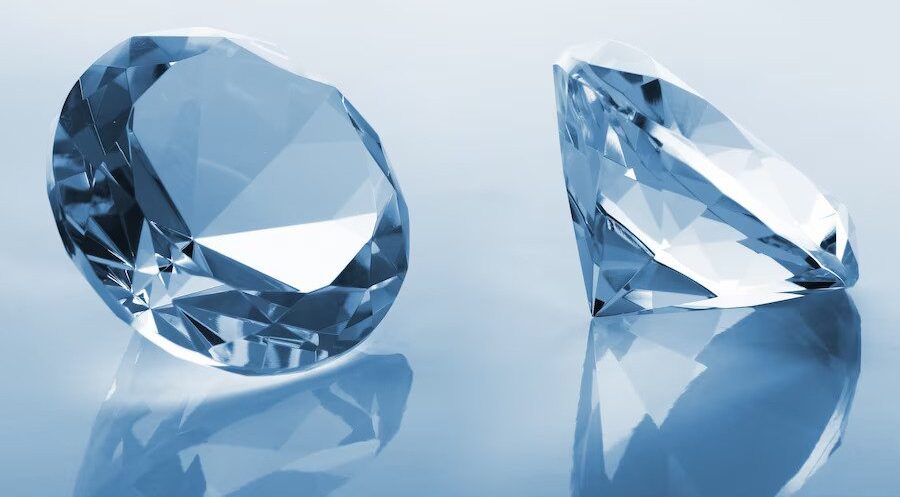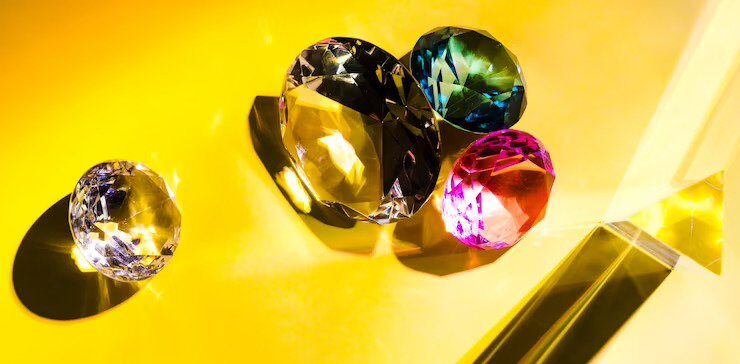Swarovski Crystals vs Diamonds
Regarding dazzling jewellery and accessories, two names often come to mind: Swarovski crystals and diamonds. Both renowned for their brilliance and beauty, Swarovski crystals and diamonds offer distinct characteristics that appeal to different preferences and budgets.
In this article, we will delve into the world of Swarovski crystals and diamonds, exploring their unique qualities, value propositions, and considerations for purchasing.
Whether seeking the perfect jewellery or contemplating a gift, understanding the differences between Swarovski crystals and diamonds can help you make an informed decision.
Swarovski Crystals vs Diamonds
Composition and Origin
Let’s start with the basics. Swarovski crystals represent manufactured, precision-cut crystals created by Swarovski, a renowned Austrian company founded in 1895. These crystals are made from a combination of quartz, minerals, and other elements to achieve their exceptional clarity and sparkle. Swarovski crystals are known for their precise cuts, vibrant colours, and consistent quality, making them a popular choice for jewellery, fashion accessories, and home décor.
On the other hand, diamonds are natural gemstones formed deep within the earth over millions of years. They are composed of carbon atoms arranged in a crystalline structure, which gives them their unmatched hardness and durability.
Diamonds come from various regions worldwide, including Africa, Australia, Russia, and Canada. Natural diamonds undergo extensive cutting, polishing, and grading processes to enhance their beauty and maximise their value.
Value and Cost
The value and cost of Swarovski crystals and diamonds differ significantly due to their composition, rarity, and market demand. Swarovski crystals are relatively affordable, making them accessible to many consumers.
The crystals’ design, craftsmanship, and size primarily influence the cost of Swarovski crystal jewellery. Swarovski crystals offer an affordable way to add sparkle and elegance to one’s jewellery collection without breaking the bank. That’s why you can always find high quality Swarovski pendant wholesale.
Diamonds, on the other hand, are highly valued for their rarity and enduring beauty. The value of diamonds comes from the famous “Four Cs”:
- Carat weight
- Colour
- Clarity, and
- Cut
Larger diamonds, those with excellent colour grades, high clarity, and exceptional cuts, are costlier. Additionally, natural diamonds represent a long-term investment as they hold their value and can even appreciate over time. The cost of diamonds can vary greatly depending on these factors, with rare and exceptional diamonds commanding premium prices.
Sparkle and Brilliance
One of the primary attributes that captivate jewellery enthusiasts is the sparkle and brilliance of gemstones. Swarovski crystals are known for their unique light refraction, which produces a captivating sparkle.
Swarovski utilises a proprietary cutting technique that allows their crystals to reflect light in many directions, creating a dazzling display. The precision-cut facets of Swarovski crystals enhance their brilliance, giving them a brilliant, eye-catching appearance.
Diamonds, however, have a reputation for their unparalleled sparkle and brilliance. Their natural hardness and unique refractive index contribute to their extraordinary light dispersion and scintillation.
Diamonds can refract and reflect light, creating an awe-inspiring play of colours and a mesmerising sparkle. This exceptional brilliance is one of the key reasons why diamonds have long been treasured and sought-after as the ultimate symbol of luxury and elegance.
Durability and Hardness
Durability is a crucial factor to consider when evaluating gemstones for long-term wear and daily use. While renowned for their beauty, Swarovski crystals are less durable than diamonds.
Swarovski crystals have a Mohs hardness rating of approximately 6-7, making them susceptible to scratches and abrasions if not handled carefully. While they suit most jewellery applications, learn to protect Swarovski crystal jewellery from potential damage.
Conversely, diamonds are the hardest known natural substance, ranking 10 on the Mohs scale. Their exceptional hardness ensures they can withstand daily wear without scratching or losing their lustre.
This hardness also makes diamonds ideal for engagement rings and other jewellery pieces that require long-term durability and resistance to wear.
Ethical Considerations
In recent years, ethical and environmental concerns surrounding the mining of natural diamonds have increased interest in alternative options. Swarovski crystals, being artificial, are often considered a more ethical choice.
Swarovski has a solid commitment to sustainability and responsible sourcing. They adhere to strict ethical standards and ensure that their crystals are produced in an environmentally friendly manner.
In response to ethical concerns, the diamond industry has introduced conflict-free diamonds, also known as “ethical diamonds.” These diamonds come from regions and mines that adhere to ethical labour practices and environmental regulations.
Ethical diamond certifications, such as the Kimberley Process, help ensure that diamonds are not associated with human rights abuses or armed conflicts.
Conclusion
Both Swarovski crystals and diamonds have their unique charm and appeal. Whether you opt for the brilliance of Swarovski crystals or the everlasting elegance of diamonds, both can bring joy, beauty, and a touch of sparkle to your appearance.


















